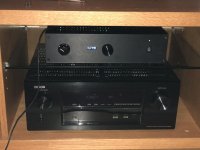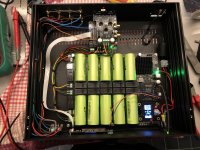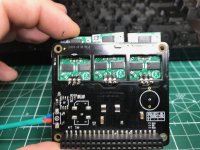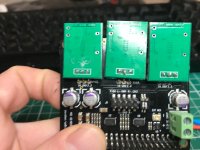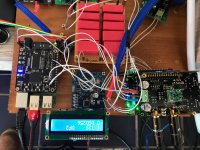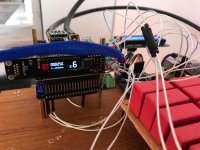Yay! It’s making some sweet tunes. Thank you very much Ian.
@ Morde,
It looks great! You did good job. Much better than my hard wood base
Maybe you can also move the OLED board of the LifePO4 power supply to the front panel.
Looking forward to your new upgrade.
Regards,
Ian
Try setting the uber small micro-switch S1-1 on the bottom of FifoPi ultimate to ON. The default is off. You would not know this without reading the documentation. That should do it. It worked for me using roon. What MPD are you using? My son and I tried it last weekend and once S1 was changed it recognized native DSD tracks and 'DSD' was displayed on the ESS controller. Of course we tore our hair out a little in the process, discovering that was what needed changing.
I misspoke re DSD. Meant to say DoP (DSD over PCM). Shows up on the ESS controller as being converted via DoP and displayed as a DSD native file.
@iancanada, could you please use an Ethernet PHY that supports hardware timestamps (like Intel 210at) in your ReceiverPi? It would make using something like Ravenna or AVB for multi-room or active speaker playback possible.
Thanks!
Can you give me more information about that?
Ian
Can you give me more information about that?
Ian
So the most common protocol to do time synchronization between devices is NTP but that can be accurate to tens of milliseconds at best. PTPv2 (IEEE 1588) is another protocol that can theoretically go down to a nanosecond but to do it it relies on timestamps embedded in network packets being processed by the Ethernet interface itself and passed to a Linux kernel module in order to reduce the processing latency.
In order to achieve a consistent and accurate synchronization between rooms or left/right channels one wants to use PTPv2. Protocols like Ravenna and AVB used for realtime low latency audio distribution require it.
Linuxptp project is the current implementation I'm looking at for general Linux support and can use software processing of the timestamps but it's not much better than NTP in that mode. Most SBCs currently use the realtek rtl8111 chips which do not support hardware processing of the timestamps. The Intel 210/211 do support hardware timestamps and the corresponding igb Linux module has support for that as well.
Hi Terry,
Never tried that, but would be interested to know how it turns out if you decide to.
Hi guys,
Just tried Ian 9038 dual mono + fifoPi + ak4137 upsampling to dsd256 + Markw4 Film bank for +-15v + 1 sparkos 3306
And it sounds very very good to my ears. More details and more softness all together. Very nice separation of instruments too.
I think I prefer it over my Katana THD. But I have to listen more.
Upsampling was also a real improvement on my cheap chinese 9038q2m.
I will try to add TP 3.3v regulators to the dac board, Could some of you confirm that it is the right way to do it(see picture)?
thank you
Attachments
Hi guys,
I will try to add TP 3.3v regulators to the dac board, Could some of you confirm that it is the right way to do it(see picture)?
thank you
Looks like you're powering the regs with the higher voltage (say 5~6V) to the DAC board's primary DC input terminal. You may want to check with Ian just to be sure it is okay (e.g., see if any caps along the way are rated for that voltage) although it should be, as I'm powering the three rails separately using 3 battery rails and with no connection to the primary DC terminal.
Hi guys,
Just tried Ian 9038 dual mono + fifoPi + ak4137 upsampling to dsd256 + Markw4 Film bank for +-15v + 1 sparkos 3306
And it sounds very very good to my ears. More details and more softness all together. Very nice separation of instruments too.
I think I prefer it over my Katana THD. But I have to listen more.
Upsampling was also a real improvement on my cheap chinese 9038q2m.
I will try to add TP 3.3v regulators to the dac board, Could some of you confirm that it is the right way to do it(see picture)?
thank you
@terry22
Looks very nice, you did good job. Congratulations!
How do you like the ak4137 real time upsampling to dsd256? What the impress of the sound quality by comparing with original PCM/I2S?
And what was showing on the ESS controller OLED screen when AK4317 is in working?
Regards,
Ian
Looks like you're powering the regs with the higher voltage (say 5~6V) to the DAC board's primary DC input terminal. You may want to check with Ian just to be sure it is okay (e.g., see if any caps along the way are rated for that voltage) although it should be, as I'm powering the three rails separately using 3 battery rails and with no connection to the primary DC terminal.
@jacklee,
I saw he has three low noise regulator boards on the ES9038Q2M dual mono HAT. So it should be no problem for 5-6V DC input.
Theoretically three 3.3V pure battery rails would be a better option. But will need at least two LifePO4 power supplies. How do you like this configuration? How much improvement on sound quality do you think by comparing with only one 3.3V battery rail?
Regards,
Ian
Hi terry22,
Looks good. The next thing to try, if you want, would be to run the dac and the AK4137 from the same clock. 25MHz is about maximum for AK4137, but it could could still upsample to DSD256 (@12.5MHz in that case). If you do decide to try it, I found that the AK4137 boards I have always use the 22.5MHz clock for DSD, so that is the one I removed and replaced with a u.fl connector.
Interestingly, I have the data sheet for the new AK4499 dac evaluation board, and that's exactly what they have done. There is an AK4118 serial receiver, and AK4137 SRC, and the AK4499 all on one board, and the AK4137 and AK4499 both run using the same MCLK.
I know from my experiments with ES9038Q2M that particular configuration can sound better than Katana even if the Sabre dac is still running asynchronously.
EDIT: In my experiments, exact timing of clock phase between AK4137 DSD output clock and ES9038Q2M MCLK is critical for best SQ. Don't know if simply reclocking is enough or if clock phasing will need finer adjustment. So far, I have had to adjust phase within 150ps or so to find best SQ.
Looks good. The next thing to try, if you want, would be to run the dac and the AK4137 from the same clock. 25MHz is about maximum for AK4137, but it could could still upsample to DSD256 (@12.5MHz in that case). If you do decide to try it, I found that the AK4137 boards I have always use the 22.5MHz clock for DSD, so that is the one I removed and replaced with a u.fl connector.
Interestingly, I have the data sheet for the new AK4499 dac evaluation board, and that's exactly what they have done. There is an AK4118 serial receiver, and AK4137 SRC, and the AK4499 all on one board, and the AK4137 and AK4499 both run using the same MCLK.
I know from my experiments with ES9038Q2M that particular configuration can sound better than Katana even if the Sabre dac is still running asynchronously.
EDIT: In my experiments, exact timing of clock phase between AK4137 DSD output clock and ES9038Q2M MCLK is critical for best SQ. Don't know if simply reclocking is enough or if clock phasing will need finer adjustment. So far, I have had to adjust phase within 150ps or so to find best SQ.
Last edited:
@terry22
Looks very nice, you did good job. Congratulations!
How do you like the ak4137 real time upsampling to dsd256? What the impress of the sound quality by comparing with original PCM/I2S?
And what was showing on the ESS controller OLED screen when AK4317 is in working?
Regards,
Ian
Hi Ian,
the controller is showing DSD256/11.2896MHz
As I said in my message, to my ears it is a real imrovement.
More "airy" sound, more detailed and more softness in the highs.
it is difficult for me to describe it weel. But it is noticeable.
I didn't tried upsampling without the film bank. So it's a mix of the 2 mods and I changed an opamp too. I would have to test each mods separately.
But for now, I prefer to enjoy the great music it plays
Thank you again for your great work.
I will now try the tp regulators and next I will try better clocks when I'll receive them.
Attachments
Hi terry22,
Looks good. The next thing to try, if you want, would be to run the dac and the AK4137 from the same clock. 25MHz is about maximum for AK4137, but it could could still upsample to DSD256 (@12.5MHz in that case). If you do decide to try it, I found that the AK4137 boards I have always use the 22.5MHz clock for DSD, so that is the one I removed and replaced with a u.fl connector.
Hi Mark,
Thank you for the good idea.
I have a spare ak4137, so maybe I'll give a try.
So the only clock used in the whole system will be the FifoPI one, which will connect to both dac and ak4137, is that right?
Looks like you're powering the regs with the higher voltage (say 5~6V) to the DAC board's primary DC input terminal. You may want to check with Ian just to be sure it is okay (e.g., see if any caps along the way are rated for that voltage) although it should be, as I'm powering the three rails separately using 3 battery rails and with no connection to the primary DC terminal.
Hi Jacklee,
At start I wanted to power each reg separately but I need one more PSU to do that. Maybe I'll try it later.
Did you compared SQ between powering the card in 5v and powering the 3 regs separatly?
Hi Ian,
the controller is showing DSD256/11.2896MHz
As I said in my message, to my ears it is a real imrovement.
More "airy" sound, more detailed and more softness in the highs.
it is difficult for me to describe it weel. But it is noticeable.
I didn't tried upsampling without the film bank. So it's a mix of the 2 mods and I changed an opamp too. I would have to test each mods separately.
But for now, I prefer to enjoy the great music it plays
Thank you again for your great work.
I will now try the tp regulators and next I will try better clocks when I'll receive them.
@terry22
That's really great. I would be interested in trying the AK4137 later when I have time.
BTW, I saw you plugged the ESS controller directly on to the DAC HAT. What I would suggest is to plug it into the non-isolated GPIO of FifoPi, it will become an isolated ESS controller under this configuration
Regards,
Ian
Hi Mark,
Thank you for the good idea.
I have a spare ak4137, so maybe I'll give a try.
So the only clock used in the whole system will be the FifoPI one, which will connect to both dac and ak4137, is that right?
Presumably so. I have been doing something a bit different, however. My ES9038Q2M is clocked at 100MHz. An LMK01000 clock divider is used to divide the dac MCLK (taken from a dac chip GPIO pin) by a factor of 4. That gives the 25MHz synchronous clock to run the AK4137. It turns out that LMK01000 can delay the divided clock output in 150ps steps, and so far in the situation here it looks like that exact delay timing is critical for best SQ. However, don't know if there would be as much of that type of effect at lower clock frequencies. Also, don't know if reclocking D-flip flop propagation delay as some systems use could produce a less than ideal phase delay between the DSD clock and the dac MCLK. Still too many unknowns, I'm afraid
@terry22
BTW, I saw you plugged the ESS controller directly on to the DAC HAT. What I would suggest is to plug it into the non-isolated GPIO of FifoPi, it will become an isolated ESS controller under this configuration.
Regards,
Ian
Thanx Ian, it was just for testing. it is now on the fifopi.
terry22,
Please let us know when you try the new voltage regulators. They should probably work well for DVCC and VCCA.
I would be most interested to see how sound quality associated with AVCC turns out (since ADM7150 is sometimes use for AVCC on PRO chips). Don't know if the lower current draw of the Q2M chip will interact differently at all with the regulator in terms of audibility. The reason I say that is sometimes regulators may sound better if operated at some current reasonably above idle. In some cases, adding a suitable resistor from the output to ground has been reported to help.
Please let us know when you try the new voltage regulators. They should probably work well for DVCC and VCCA.
I would be most interested to see how sound quality associated with AVCC turns out (since ADM7150 is sometimes use for AVCC on PRO chips). Don't know if the lower current draw of the Q2M chip will interact differently at all with the regulator in terms of audibility. The reason I say that is sometimes regulators may sound better if operated at some current reasonably above idle. In some cases, adding a suitable resistor from the output to ground has been reported to help.
@jacklee,
Theoretically three 3.3V pure battery rails would be a better option. But will need at least two LifePO4 power supplies. How do you like this configuration? How much improvement on sound quality do you think by comparing with only one 3.3V battery rail?
Regards,
Ian
The main benefit from separate battery rails for the DAC HAT is eliminating the last bit of digitis - slight grit in the high frequencies. The sound becomes much more liquid and smooth, definitely an improvement (a must I'd say) and worth adding an extra battery board just for that (although one can also do that w/ a single battery board if the transformer output board is used).
Hi Jacklee,
At start I wanted to power each reg separately but I need one more PSU to do that. Maybe I'll try it later.
Did you compared SQ between powering the card in 5v and powering the 3 regs separatly?
Yes, see my reply to Ian above. Btw, if one is using battery (3.3V) then bypassing the on-board reg already brings a step-up in sound - more clarify and definition (see Ian's manual for how, 2 solder joints). The 3 battery rails take it further still.
- Home
- Source & Line
- PC Based
- ES9018K2M, ES9028Q2M, 9038Q2M DSD/I2S DAC HATs for Raspberry Pi
